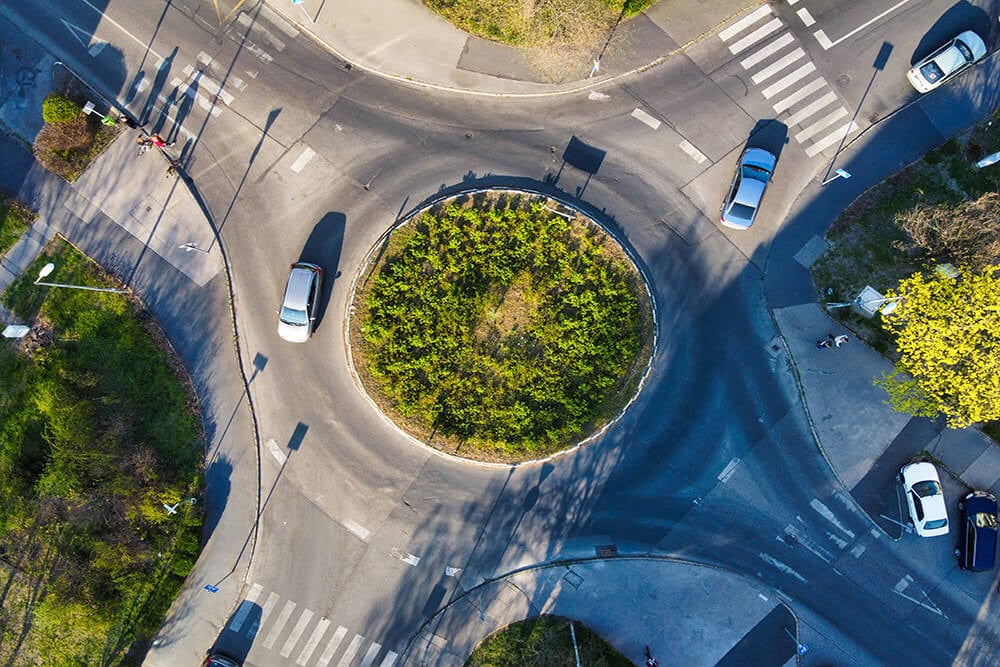
While driving is a necessary part of almost everyone’s life, about 1 in 57 people are involved in traffic crashes per year according to data collected by Pennsylvania’s Department of Transportation in 2019. Not surprisingly, though, a little over ¼ of those involve a vehicle at an intersection or while taking a turn.
For most drivers, turning in an intersection that has a light or stop sign is fairly comfortable since the signage and traffic indicators determine when we should move. But sometimes we encounter a different type of intersection with a less common mechanism: a traffic circle. This seemingly simple roundabout is confusing for many drivers and presents an undeniable challenge for new or less confident drivers. Let’s take a look at how traffic circles work, how the law supports drivers in them, and what you should know if you are involved in an accident while driving in one.
How Does a Traffic Circle Work?
Roundabouts, as traffic circles are often called, are circular intersection systems created to maintain traffic flow. Drivers will not automatically have to stop at the intersection of a traffic circle if no other cars are present or if the other vehicles are not approaching. When arriving at a traffic circle, a car most likely can merge into the clockwise-moving traffic unless the circle is full. Once a vehicle has merged into the circular roadway, the car will follow the circular path until reaching the exit location needed to continue on a different roadway direction.
Unique in design, the traffic circle reduces the need for vehicle stops and traffic congestion by providing a constantly flowing traffic pattern. But unlike an intersection with a stop sign or traffic light, roundabouts rely on drivers following the road rules regarding yielding and right of way to stay safe.
Pennsylvania Traffic Laws: Yield vs. Right of Way
Many drivers might think that they are legally given the right of way in certain circumstances. But surprisingly, Pennsylvania regulations actually only define which vehicle is required by law to yield or give way, to another vehicle or person. This means that drivers must understand when they should allow another vehicle to go ahead, or have the right of way, and when their own car must be yielded to. In the case of a traffic circle, the approaching cars not yet inside of the roundabout are the ones required to yield. So, a car already in the circular path of the traffic circle legally has the right of way. Cars wishing to enter the roundabout must yield to them, waiting for a clear and safe entrance location for their own vehicle.
Since the purpose of a traffic circle is to encourage a constant flow of traffic, vehicles outside of the roundabout do not have to come to a complete stop before entering the circle unless another car is in the traffic flow. When the traffic circle is full of cars, an approaching car must yield, and stop, to wait until a space opens appropriate for their own vehicle. Only then can the approaching car enter the traffic circle safely by law.
Traffic Circle Flow
Since traffic circles are not in use in all locations, many drivers simply do not have a lot of experience driving safely in them. Accidents in roundabouts may occur when an approaching car doesn’t yield to the cars already in the traffic circle flow. Drivers may not realize that the car in the circle has the right of way, and any outside cars are required by law to yield to those vehicles regardless of speed, weather or any other factors.
Pedestrians: Who Has the Right of Way in a Traffic Circle?
Pedestrians in Pennsylvania also always have the right of way when crossing a street, including crossing roadways at a traffic circle. If a pedestrian is attempting to cross any roadway connected to a traffic circle, all drivers in Pennsylvania are also required to yield to the pedestrian. While pedestrian safety is clearly vital, drivers inside the traffic circle may not always know what their responsibilities are when people walk near or in a traffic circle. All cars, both in the traffic circle and approaching the circle, must yield when pedestrians are present.
Accidents in Traffic Circles
When drivers do not understand who has the right of way and who should yield in a traffic pattern of a roundabout, accidents can happen. If you are involved in a crash in a traffic circle that was caused by a driver’s negligence, you may have grounds for legal action. To learn more, get in touch with Stapp Law, LLC today. We understand Pennsylvania laws and are prepared to whatever it takes to ensure justice is upheld.






